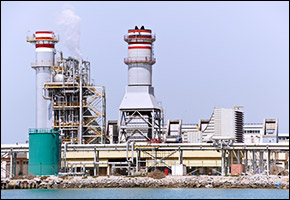Peter Gleick: Salt from Water: The Question of Energy

Following up on my last post, on the cost of desalination, I thought I’d tackle a second key issue that seems to interest people: how much energy it takes to desalinate seawater.
The short, non-technical answer is, a lot. And the more salt there is in water, the more energy is needed to remove it. This is one of the reasons desalination is expensive. The other is that the equipment itself is costly – this is a high-tech, capital-intensive way to produce fresh water.
When salt is dissolved in water, it breaks the ionic bonds that hold salt crystals together. Removing those salt ions from water takes substantial amounts of energy.
Water Number: 0.7
In an ideal reversible thermodynamic process, a minimum of around 0.7 kilowatt-hours of energy are needed to desalinate a cubic meter (cu.m) of seawater (a cubic meter is 1000 liters, or 264 gallons). Current state-of-the-art reverse osmosis (RO) desalination plants use 2.5 to 7 kWhr/cu.m.
The “minimum” number above is a true minimum for producing tiny amounts of fresh water. If we want to get commercially useful amounts, the minimum energy required goes up to around 0.9 kWhr/cu.m, and for practical reasons, RO plants will never get to this level. (I note that far less energy is required to desalinate water with less salt, such as brackish water – this explains why brackish water desalination can be far less expensive.)
In actual desalination processes, additional energy is required above the minimum because of a wide range of practical factors. In particular, RO requires high pressures to produce practical fluxes of water across the membranes and energy is needed to produces these pressures. Even more energy is needed to run pumps and other parts of the process.
There is an excellent discussion of these issues in the report of the National Academy of Sciences. Desalination: A National Perspective, published in 2008 by the National Academies Press, in Washington D.C. concluded that the practical upper limit of energy savings that can plausibly be realized through improvements in RO membranes is around a 15% improvement over current RO systems. “The RO process is approaching a state of diminishing returns as it relates to energy usage.”
Other desalination experts agree: “We are very close to the minimum energy for desalination,” says Juan Maria Galtes, director of special projects for Inima – a Spanish company that has built and operates dozens of seawater desalination facilities. “There’s a point where it’s impossible to go any further.”
Significant improvements would require a breakthrough in a technology other than RO. Other processes can use waste heat or other less energy-intensive thermodynamic processes, but these are less attractive than RO at present because of other technical and economic constraints. Because energy costs run about 40 to 50% of the total costs of desalinated water, further reductions in energy requirements can only slightly reduce the overall costs, and such improvements can easily be overwhelmed by fluctuations in energy prices themselves. In fact, for a while last year when energy costs rose dramatically, estimates of the cost of water from new desalination plants also rose dramatically.
The growing interest in desalination is also running up against the growing concern about emissions of greenhouse gases and climate change. As a result, some proponents of desalination are exploring the possibility of finding renewable, non-carbon energy sources to meet the energy needs of desalination plants. The new large desalination facility in Kwinana near Perth, Australia (which uses between 4 and 6 kWhr to produce a cubic meter of water) is at least partly served by new wind turbines at the 80 MW Emu Downs Wind Farm. For other parts of the world, finding renewables to power desalination is also likely to be required, as we look to ways to reduce our carbon emissions from all sources. In the United States, perhaps we ought to require that any desalination proposal include new, non-carbon emitting energy. It may be more costly at first, but it may also be the cost of doing business right.
For more information on desalination, click here.
Dr. Gleick’s blog posts are provided in cooperation with the SFGate. Previous posts can be found here.












Leave a Reply
Want to join the discussion?Feel free to contribute!